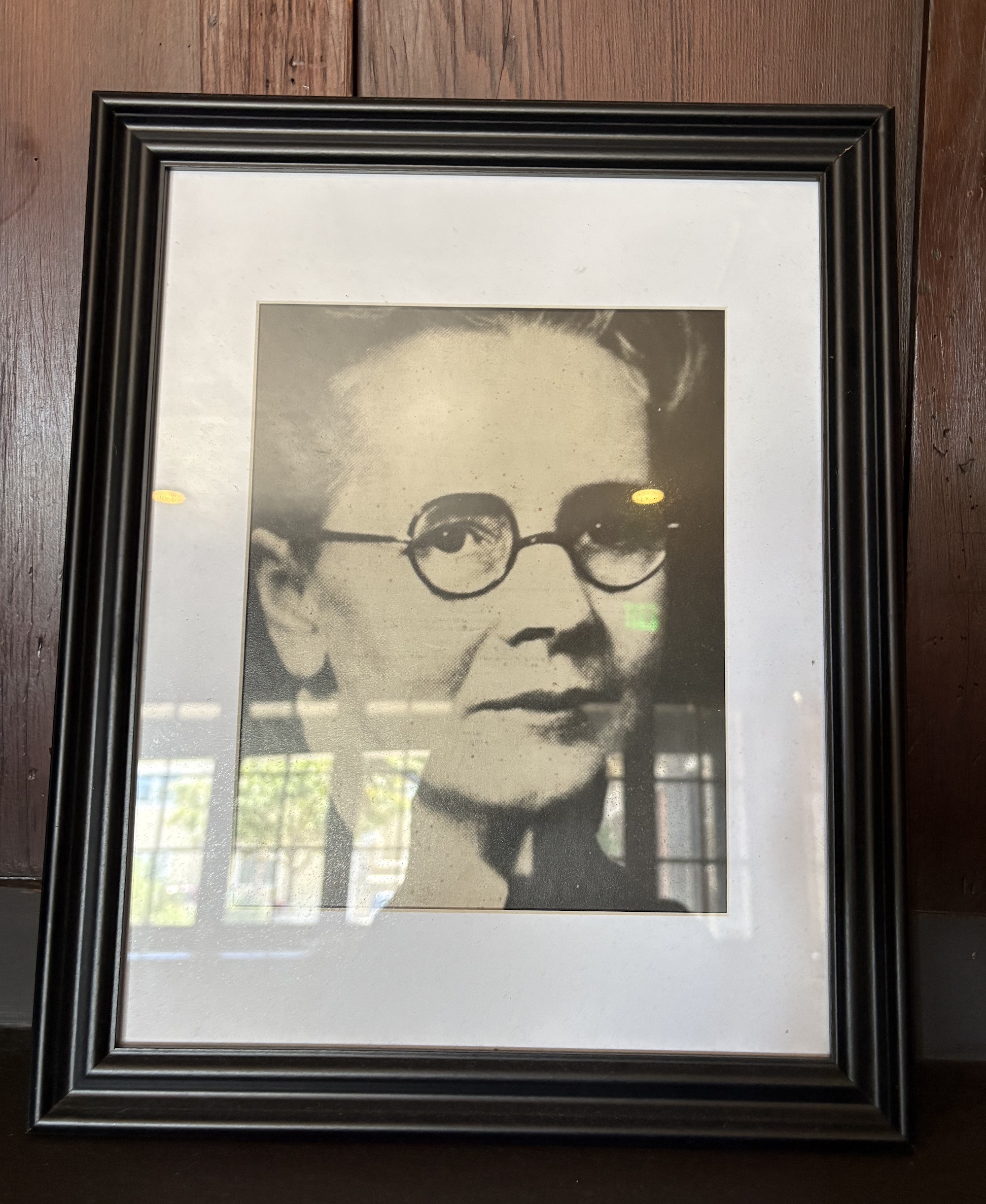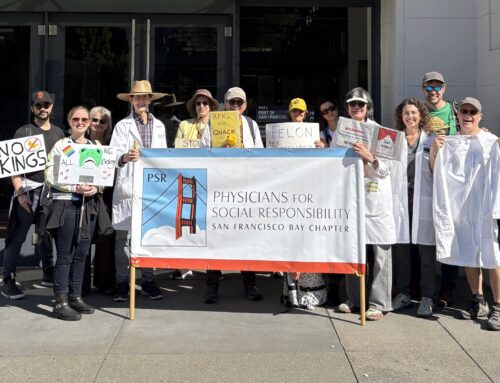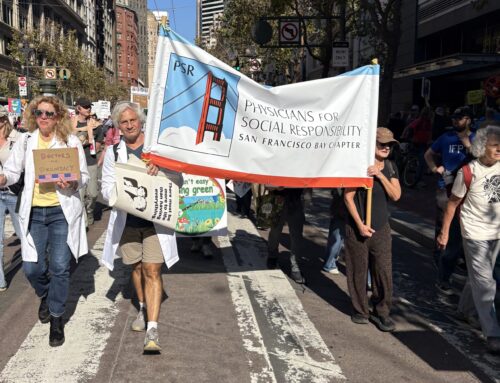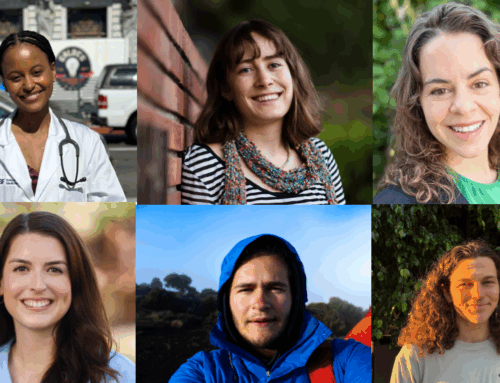San Francisco Bay Physicians for Social Responsibility’s Building Electrification Program educates the public and policy makers about the health harms of air pollution from gas home appliances and the benefits of cleaner, healthier, and more efficient electric appliances. Below is just one example of a project that we have worked on over the past year, and there are more to come!
MAY 22, 2025
We often think that windy, foggy San Francisco has good air quality, but in fact our gas appliances such as stoves, water heaters, and furnaces are producing 44% of greenhouse gas emissions in the city including many harmful air pollutants. Indoor air pollution from cooking on a gas stove in an unventilated kitchen can be similar to a person smoking at your kitchen table, or even a car running exhaust directly into the room. And indoor air pollution eventually moves outdoors, contributing to poor air pollution overall. Also, our gas water and space heaters contribute more nitrogen oxide (NOx) air pollution in the Bay Area than our passenger cars!
Who knew these gas appliances were harming our health and the climate, and compounding the health harms already present in environmental justice neighborhoods? The gas industry did their best to discredit research findings and deploy misinformation advertising campaigns calling gas, “natural” gas—but it is a fossil fuel—and we now have ample evidence demonstrating its damaging effects on health and the climate.
The solution is to replace our gas appliances with cleaner, healthier electric appliances. But how do we do that and how do we pay for it? San Francisco Bay Physicians for Social Responsibility (SF Bay PSR) is working on many fronts with California and San Francisco building electrification networks to develop solutions including educating policy makers and the public, and supporting programs to install zero-emission, electric appliances in our communities.
Most recently, SF Bay PSR helped to electrify San Francisco’s historic Potrero Hill Neighborhood House (the Nabe) which houses community meetings, a childcare center, and serves low-income families, youth, and seniors, making it an ideal location for demonstrating health-centered building improvements. Also, we chose this site because it serves the Bayview Hunters Point community, a historically underserved neighborhood in San Francisco that faces disproportionate environmental health burdens due to legacy redlining, pollution, and inadequate infrastructure.

Enola D. Maxwell: Executive Director of the Nabe 1972-2003, first African-American and woman to be named a lay minister with the Presbyterian Church, civil rights activist.

Julia Morgan: first woman to be a licensed architect in California, designer of the Nabe, Hearst Castle, and 700+ more buildings.
This project was a model collaborative effort led by SF Bay PSR in partnership with Bayview Hunters Point Community Advocates (The Advocates), funded by the City and County of San Francisco’s Department of the Environment, and in partnership with technical experts at the Association for Energy Affordability (AEA). It began with community listening sessions to hear about community concerns, build trust, and ensure the community’s needs were being met.
The Nabe now has a new induction stove in the upstairs kitchen, a heat pump that heats and cools their Julia Morgan Ballroom, and a heat pump water heater. We will also be giving away portable induction cooktops to some of the families whose children attend childcare at the Nabe.
Edward Hatter, executive director of the Nabe explained with a big smile: “We can now have events in the Julia Morgan Ballroom without having to heat the entire building. And it heats up the large space within two hours, compared to twenty-four hours with our relatively new gas boiler system. This means a huge cost savings in energy bills! To fully heat the community center in the winter, we used to have to burn logs in the fireplace, which of course is not convenient and greatly adds to poor air quality. The new heat pump system is easy to operate, controls the temperature better than our boiler system, with fans to more evenly distribute the heat. Also, it is so quiet! This is particularly helpful during performances and weddings.”

Edward Hatter, Nabe Executive Director, next to their new heat pump water heater!

The new heat pump / air conditioning unit for the Julia Morgan Ballroom.

The Julia Morgan Ballroom. Note the fans for better air circulation.
To teach the staff how to use the new induction cooktop and stove (and new pots and pans) in the upstairs kitchen, Dr. Mary Williams, SF Bay PSR board member, made lunch for the staff while providing a demonstration and explanation of the health harms of gas stove air pollution. The new stove will greatly improve air quality upstairs, which is particularly important because gas stove pollutants can trigger asthma, especially in children, and contribute to heart and lung disease as well as dementia in adults. So, the new induction stove provides many health benefits.
However, nothing is perfect. Michelle Pierce, executive director of the Advocates gave a warning that many do not realize: “Dropping heavy pans on the glass cooktops of electric and induction stoves can break the glass. So, you have to be more gentle than you do with a gas stove that has iron grates on top of the burners. This is important to consider if you have heavy pans and an elder who may not have the strength to lift them easily. However, you can get rubber pads to protect the glass that can be left on an induction cooktop while cooking.”

Edward Hatter with the new pots and pans for the induction stove. Any pan that a magnet will stick to will work.

New induction cooktop. Read about how this technology works here! Professional chefs love induction, learn why here.
Find here our Building Electrification Resources page with facts about the health harms of air pollution from gas appliances, gas stove pollution facts, and how you can protect your family.
Learn about SF Climate Equity Hub Resources: Free Heat Pump Water Heaters for Income-Qualified Families (as of May 2025).
This project directly benefits the communities who use the Nabe, but it is also a place for many more San Francisco residents to learn about the benefits of building electrification, and it serves as a case study for future projects.
Dr. Bob Gould, SF Bay PSR board president commented: “This project exemplifies what we at SF Bay PSR strive for—serving our environmental justice communities by combining the power of community activism with the knowledge and credibility of health professionals to support a healthier environment and just transition to building electrification for all our communities.”
We learned a lot from this pilot project. Most importantly, BE projects require a more holistic approach to creating healthier buildings and homes. For example, simply replacing a gas furnace with a heat pump may not decrease a resident’s energy bills if the home has not been weatherized; the old windows may need to be replaced too. Also, when installing a new electric appliance, other structural issues often emerge such as the need for new wiring or finding stove ventilation that will not ruin the roof, as was the case at the Nabe. Funding needs to include contingency for these unforeseen costs. We also learned that technical experts such as our partner AEA are needed in the beginning when engaging with building owners because many more technical questions came up than we initially anticipated.
Our key takeaways are that community-centered building electrification is achievable and impactful when led by trusted organizations, backed by technical support, and aligned with resident needs and health goals. The Nabe retrofit will serve as a local model for healthier indoor environments and improved air quality in EJ communities.
Our key recommendations are that future BE projects build in funds for community stipends and transportation to maximize engagement and allow for flexibility in timelines to adapt to site-specific and partner-related delays. Also, educational campaigns should continue post-installation to ensure sustained awareness and behavior change.
To that end, SF Bay PSR will be working closely with San Francisco Environment Department’s Climate Equity Hub partners to develop more community outreach materials over the next few years.




